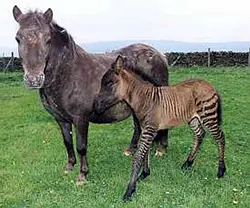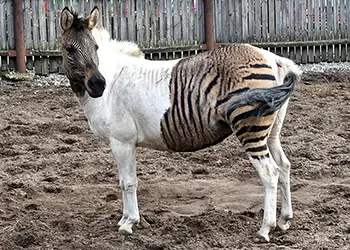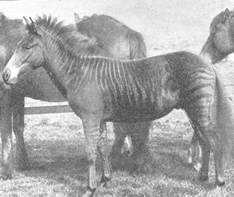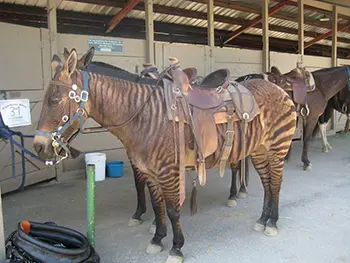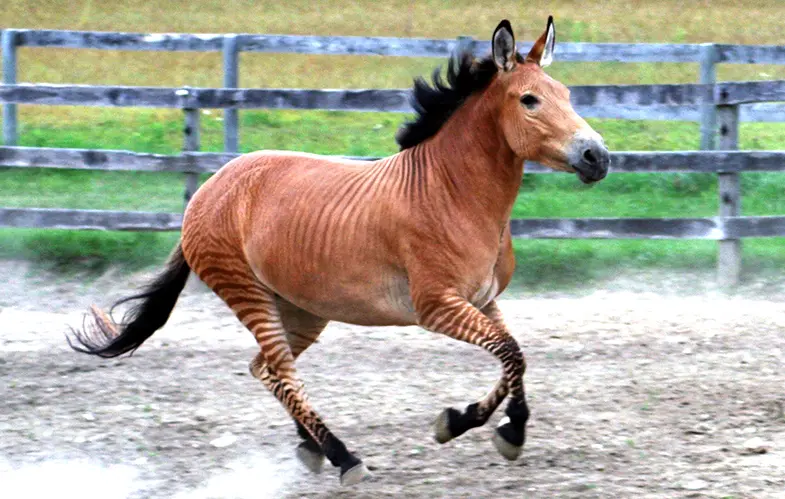One of the things I love about teaching kids to ride is their inquisitive minds and the questions they ask, just recently I was asked by a seven year old boy if horses and zebras could have babies and if they did could you ride them. While I’d often been asked about whether or not horses and donkeys could mate I’d never been asked about zebras which started me thinking.
Can horses and zebras mate? Despite being from separate species of the Equus family, zebras and horses are more than capable of mating and producing a healthy foal although this would never happen in the wild.
While researching this question I came across Charles Darwin’s Origin of the Species, a book that whilst I did study in high school I’d not thought about much since graduating many moons ago. While he doesn’t specifically mention a zebra and horse mating, he does refer to four colored drawings of hybrids between a zebra and an ass. This intrigued me to find out more about why horses and zebras are crossbred.
What do you call a horse and zebra cross?
There are a number of different names for a horse and zebra cross, depending on whether the horse or zebra is the stallion. That said though, the general term for any zebra and equine (regardless of whether it’s a horse or ass) cross is a zebroid. The reason for this is because the general rule for naming hybrids combines the name of male species with that of the female’s, and with male zebras and female equines being far more common the zebra’s name takes precedence.
With this naming convention in mind, a male zebra and female horse mating will produce a zorse, although they are sometimes also referred to as zebroses or zebra mules. Likewise, a female zebra and male horse (while far less common) would produce a hebra or horsebra, which is also sometimes called a zebra hinny.
Can a pony and a zebra mate?
Like horses, ponies are capable of mating with zebras but due to the size difference, there have been no occurrences of a female pony ever mating with a zebra. This is because, while they can genetically, a female pony hasn’t evolved to be able to carry an animal the size of a zebra.
This means that most zebra and pony crosses are known as zonies, I say most because some people have crossed zebras with smaller pony breeds (such as the Shetland Pony) to produce a miniature looking zebra known as a zetland.
What do Zebroids foals look like?
As a general rule, zebroids look more like their non-zebra parent but with slightly larger heads, longer muzzles, and large dark eyes. In terms of the stripes, they rarely cover the whole of the body and are mainly confined to the legs, neck, and head.
If, however, the horse parent has appaloosa or pinto coloring then the stripes are only present on the non-white areas, making for an exceptionally striking animal. If the horse parent is chestnut or bay then the resulting foal is said to be a golden zebra and closely resembles the now extinct quagga. Unlike zonkeys (zebra and donkey crosses) Zebroids don’t always have a dorsal stripe along their backs, although some do.
While it doesn’t always happen many zebra crossings tend to have a mild form of dwarfism which means they’re often a lot smaller than their horse parent.
Why are horses and zebras crossed?
Its believed that horses and zebras were originally bred as far back as the 18th century in an attempt to create a new domesticated animal that was easier to train and more comfortable to ride than a zebra but was also stronger and had more stamina than the horse. The theory was that this new breed could be able to carry people and goods across the African continent.
The oldest known zorse was a one year old foal, called Romulus (pictured left), believed to have been born in 1898, a photograph of the foal was published in J. C. Ewart’s 1899 book The Penycuik Experiments. Even today this book is praised by scholars for its cultural importance.
Zebras are far more resilient to many fly-borne diseases (such as equine piroplasmosis (a form of malaria) and yellow fever) than horses so it was also hoped that this new breed would have the same level of immunity.
While zebroids are considered rare in many parts of the world they are still regularly bred in Africa and are used as trekking and pack animals that are capable of carrying a great deal of weight over long distances.
Can you ride a horse and zebra cross?
Zebras have very different body shapes to horses but when the two are bred together the resulting offspring has a body shape that’s more akin to that of a horse which means that it’s much easier to find tack that fits them. That said though it doesn’t necessarily mean that, just because a saddle fits, they can be ridden.
In theory, it is possible to ride a zebroid but they are far more temperamental than horses and much harder to train. The problem is that zebras are still wild animals and pass their survival instincts down to all of the offspring (regardless of whether the other parent is a zebra or not). While this means that the foal is less likely to run at the first hint of danger it also means that they can be more aggressive towards humans.
That doesn’t mean it’s impossible to train them to be ridden, it just means that most horse training methods either won’t work or will take longer. If, however, you can train a zebroid to be ridden then you will have an animal that has the versatility of a horse combined with the stamina and endurance of the zebra.
Can a horse and zebra create a new species?
It would be nice to think that we could one day have a new species that had the personality traits (and trainability) of horses along with the striking coat pattern that makes zebras so eyecatching but this sadly will never happen.
Apart from the fact that horses and zebras aren’t likely to meet in the wild, around 99.999% of all zebroids are sterile and will never be able to reduce. The reason for this is due to the fact that, while they’re both from the same equid family (the genus Equus) they are actually two very different species with differing numbers of chromosomes.
Depending on the species zebra have between 32 and 46 chromosomes while horses have 64 (although the Przewalski does have 66). This difference means that the resulting offspring will have exactly half the difference (this means that, depending on the species of zebra the foal will have either 48, 54, or 55 chromosomes). While this may not seem relevant (after all they have successfully produced a foal), what it does mean is that the offspring will either be completely sterile, if it’s a colt, or very poorly fertile if it’s a filly.
Further reading
If you enjoyed this article then you might also like the following articles:
- What’s the difference between a horse and a pony?
- How does the world look to a horse?
- Can horses find their own way home?
- How long do horses live for?
- Do horses enjoy being ridden?
I hope you found this article helpful. If you did I’d be grateful if you could share it please as it would really help me.
Recommended products
Over the years I have tried hundreds of different horsey products, from various blankets and halters to different treats. Some I’ve loved, others I’ve hated but I thought I’d share with you my top all-time favorite products, the ones I never leave the yard without. I’ve included links to the products (which are in no particular order) that I really think are great.
- Horse Knots by Reference Ready – If you’re like me and enjoy pocket reference guides then you’ll love this knot tying guide. These handy cards can easily fit in your pocket or attach to the saddle for quick reference. They’re waterproof, durable and are color coded to make them easy to follow.
- Mane ’n Tail Detangler – Even if you never show your horse you’ll need to detangle his tail from time to time (and possibly his mane too) which is always a challenging chore! I’ve found that if I run a little bit of detangler through my horse’s tails every few days it stops them from getting matted up and makes combing them easy, even if they’re coated in mud. I don’t know if I should admit to this or not but it also works wonders on my hair.
- TAKEKIT Pro clippers – Over the years I’ve tried a lot of different clippers and while some were obviously better than others I found these to be by far the best. They are heavier than a lot of other clippers but for me, that’s a good thing, it makes them feel more sturdy and hardwearing. On top of that they have a range of speeds so are just as good for clipping your horse’s back as they are his face. I also like the fact that they come in a handy carry case but that’s not for everybody. The company that makes them is super good and incredibly helpful too, a real bonus these days. The only thing I wasn’t keen on was the fact that it doesn’t come with any oil, but that’s not a major problem as it’s not difficult to buy lubricant.
- Shire’s ball feeder – There are so many boredom buster toys out there but I like to use these every day, regardless of whether or not my horses are bored. I find that it helps to encourage my horses to problem solve by rewarding them with treats (or pieces of fruit) but it also mimics their natural grazing behavior which helps to keep them calm and de-stressed.
- Horse safe mirror – This is a strange one that many people are surprised about but I like to put horse safe mirrors in the trailers as well as in the quarantine stalls. It helps to prevent the feeling of isolation by giving the impression of other horses being around. Being herd animals horses can get extremely stressed when they feel that they’re on their own but with these stick-on mirrors, they believe that at least one other horse is with them.
- Rectal thermometer – I know this isn’t glamourous at all but it’s vital for your horse’s well-being to be able to check their temperature and a rectal thermometer is the easiest way of doing this which is why I’ve added it to the list.
Shopping lists
I’ve also put together a few shopping lists of essential items that I’ve found helpful over the years. I’ve broken the lists down into different categories rather than put everything in one massive list 😉

